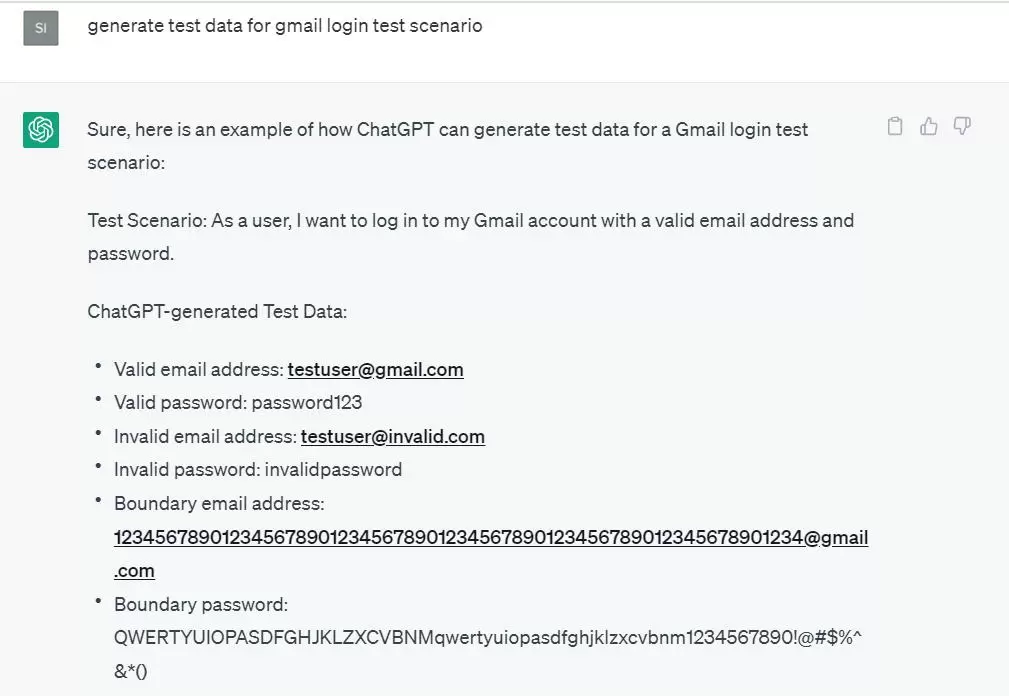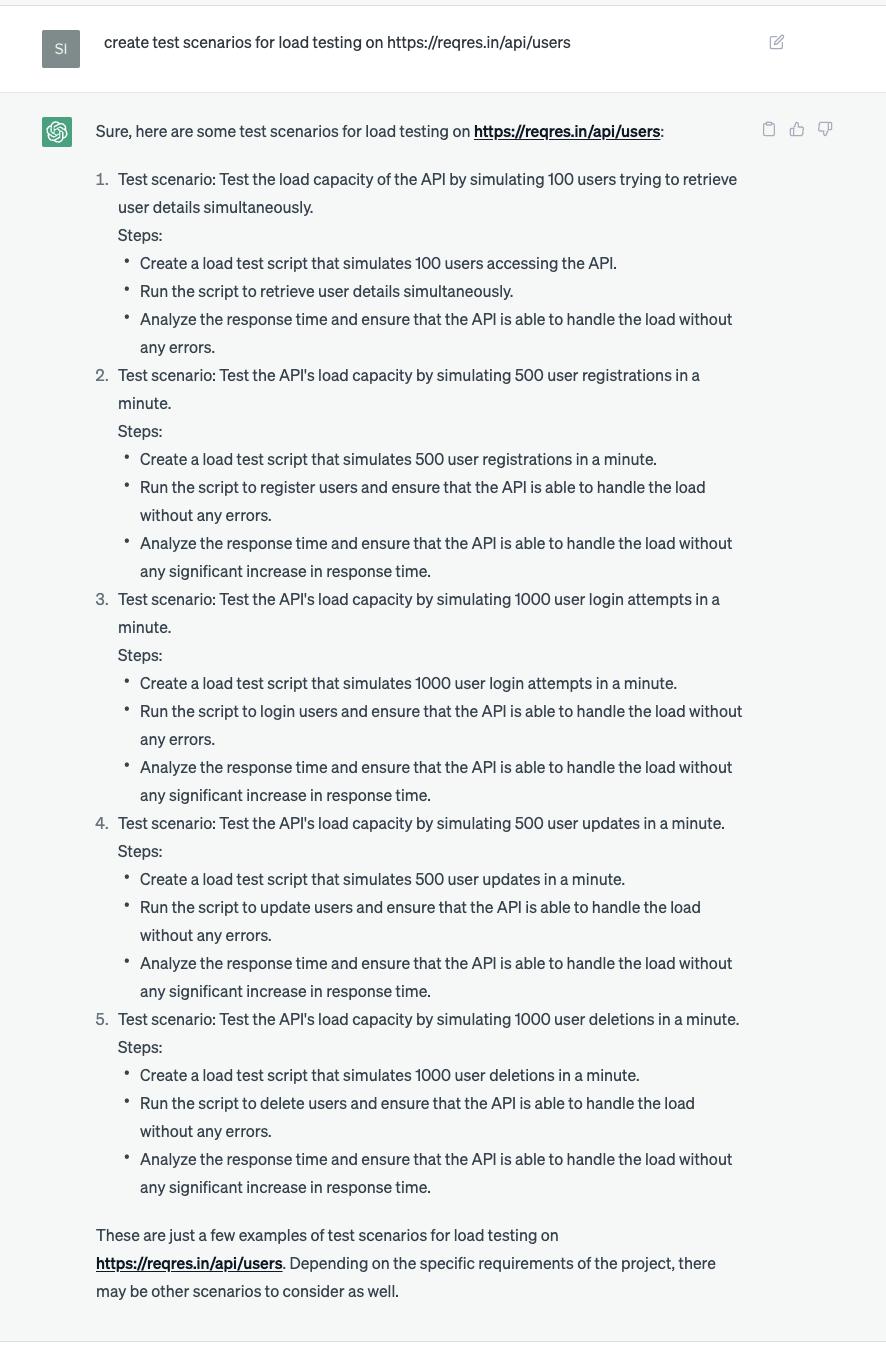Accept Cookies & Privacy Policy?
We use cookies to ensure that we give you the best experience on our website. If you continue to use this site we will assume that you accept and understand our Privacy Policy, and our Terms of Service.
As the technology landscape continues to progress, the software testing realm has also undergone significant transformations. The emergence of Artificial Intelligence (AI) has opened up new and promising possibilities for the testing industry, and ChatGPT has emerged as one of the most prospective tools in recent times.
ChatGPT is a state-of-the-art language model created by OpenAI, founded on the GPT-3.5 architecture. It is purpose-built to produce natural-sounding responses to natural language inputs, endowing it with remarkable adaptability and potency for a wide spectrum of applications, including test automation.
In this article, we’ll explore the benefits of integrating ChatGPT into your testing life cycle, and provide examples and code snippets to help you get started.
One of the main benefits of incorporating ChatGPT into your testing lifecycle is the ability to generate test cases that cover every imaginable scenario. It can be challenging to identify every possible scenario that has to be tested using traditional testing methods. Instead, you may send a user narrative or test scenario to ChatGPT, and it will generate relevant test cases that cover every imaginable circumstance.
Here is an example of how you can use ChatGPT to generate test cases for a simple user registration form:
User Story: As a user, I want to be able to register for a new account on the website.
ChatGPT Input: Generate test cases for user registration form.
ChatGPT Output:
1. Verify that all required fields are marked as mandatory.
2. Verify that the email address field only accepts valid email addresses.
3. Verify that the password field meets the minimum length requirement.
4. Verify that the password confirmation field matches the password field.
5. Verify that the user is redirected to the login page after successful registration.The speed at which ChatGPT can produce test cases is a crucial advantage of adopting it in your testing lifecycle. It might take a lot of time and effort to manually create test cases, and it can be difficult to make sure that every scenario is covered. You may rapidly and accurately develop test cases with ChatGPT, which will save you time and effort.
Here is an example of how you can use ChatGPT to generate test cases for a login form:
User Story: As a user, I want to be able to log in to the website using my email and password.
ChatGPT Input: Generate test cases for login form.
ChatGPT Output:
1. Verify that the user is redirected to the login page when not logged in.
2. Verify that the email field only accepts valid email addresses.
3. Verify that the password field meets the minimum length requirement.
4. Verify that the user is redirected to the home page after successful login.
5. Verify that the user sees an error message if the login credentials are incorrect.When using traditional testing methods, it could be challenging to find ways to improve test scripts. With ChatGPT, it is able to evaluate the results of the test cases and provide opinions about the quality of the software being tested. This might make routine script maintenance less necessary.
Here is an example of how ChatGPT can analyse the results of a test case:
Test Case: Verify that the user is redirected to the home page after successful login.
Test Result: Pass
ChatGPT Analysis: The test case has passed, and the user is successfully redirected to the home page after login. No further action is required.The capability to generate pertinent test data for various scenarios is yet another important advantage of utilising ChatGPT in your testing life cycle. By doing this, you may enhance test data management and guarantee that the data used in your tests is reliable and correct.
For testing teams, creating pertinent test data for many scenarios can be a time-consuming and difficult effort. Generating test data for diverse scenarios is considerably easier using ChatGPT. Invalid input, boundary conditions, and positive/negative input are just a few examples of the various sorts of input data that ChatGPT can generate test data that is aligned with. It can thereby enhance test data management, which eventually results in more accurate test outcomes.
Assuming we wish to create test data for logging into Gmail, we can do so by typing: “generate test data for gmail login test scenario” in the ChatGPT, and you will be surprised with the outcome. Sharing the screenshot with example below:

TestNG, Appium, and Selenium are just a few of the testing frameworks that ChatGPT is adaptable and simple to link with. This integration enables testing teams to enhance the current testing framework and increase test coverage by using ChatGPT-generated test cases that cover every imaginable scenario. The integration also helps to automate the testing process by providing test cases quickly and accurately.
Code Example: Here is an example of how ChatGPT can generate a test case for a login page:
Input: As a user, I want to log in to my account with a valid username and password.
Output: Verify that the user can log in successfully with a valid username and password.
@Test
public void validLoginTest() {
String username = "testuser1";
String password = "password123";
LoginPage loginPage = new LoginPage(driver);
HomePage homePage = loginPage.login(username, password);
assertTrue(homePage.isUserLoggedIn());
}While we cannot use ChatGPT directly to write test scripts, it can assist in generating different scenarios. For example, if we need to perform load testing on a GET method for https://reqres.in/api/users, we can leverage ChatGPT to generate relevant test scenarios, rather than starting from scratch. The screenshot below can give you an idea of how to utilise ChatGPT for performance testing.

Testing teams can get a wide range of advantages by integrating ChatGPT within the testing lifecycle. ChatGPT can effortlessly interact with testing frameworks to improve the overall testing experience, from expanding test coverage to decreasing test script maintenance, producing pertinent test data to boosting test efficiency. ChatGPT can create thorough test cases that account for every conceivable scenario thanks to the strength of natural language processing and machine learning. As a result, testing teams can considerably improve software quality while consuming less time and resources.
At Thought Frameworks, we understand the value that ChatGPT can add to your testing project. Our expert testing professionals possess a deep understanding of ChatGPT’s capabilities and can help you integrate it into your testing lifecycle to achieve optimal results. With our assistance, you can experience a game-changing transformation in the realm of automation testing. ChatGPT will enable you to achieve higher test coverage, reduce maintenance, and ultimately enhance the quality of the software being tested.

Let’s talk about GenAI and testing in 2025—the wild west of technology where machines are not just smart, but scary smart. GenAI (that’s Generative AI for the uninitiated) is running the show everywhere. It’s writing poetry, designing ads, debugging code, and probably plotting to take over my job as I write this blog.

Ah, 2024—you’ve been a year, haven’t you? For us at Thought Frameworks, this year wasn’t just about running the usual QA/QE playbook. Nope, we went full throttle into the future—tinkering, testing, and transforming everything from ERP systems to the ever-evolving world of SAP, GenAI, and security testing.

So, you’re deep in the ERP trenches and trying to figure out the best approach between NetSuite and Oracle EBS. You’re certainly not alone! We can help break down how these two ERP giants stack up when it comes to ensuring systems run like clockwork but without the overload.

So picture this: You’re the air traffic controller of a chaotic airport where the planes (developers) don’t always listen, the passengers (stakeholders) want to change destinations mid-flight, and the weather (unforeseen blockers) is always unpredictable.

Imagine a world where testing is no longer a bottleneck. No more endless cycles of manual effort, no more missed defects due to human fatigue, and no more panic at the eleventh hour before a major ERP rollout.

Imagine a world where testing is no longer a bottleneck. No more endless cycles of manual effort, no more missed defects due to human fatigue, and no more panic at the eleventh hour before a major ERP rollout.

Let’s talk about GenAI and testing in 2025—the wild west of technology where machines are not just smart, but scary smart. GenAI (that’s Generative AI for the uninitiated) is running the show everywhere. It’s writing poetry, designing ads, debugging code, and probably plotting to take over my job as I write this blog.

Ah, 2024—you’ve been a year, haven’t you? For us at Thought Frameworks, this year wasn’t just about running the usual QA/QE playbook. Nope, we went full throttle into the future—tinkering, testing, and transforming everything from ERP systems to the ever-evolving world of SAP, GenAI, and security testing.

So, you’re deep in the ERP trenches and trying to figure out the best approach between NetSuite and Oracle EBS. You’re certainly not alone! We can help break down how these two ERP giants stack up when it comes to ensuring systems run like clockwork but without the overload.

So picture this: You’re the air traffic controller of a chaotic airport where the planes (developers) don’t always listen, the passengers (stakeholders) want to change destinations mid-flight, and the weather (unforeseen blockers) is always unpredictable.

Imagine a world where testing is no longer a bottleneck. No more endless cycles of manual effort, no more missed defects due to human fatigue, and no more panic at the eleventh hour before a major ERP rollout.

Imagine a world where testing is no longer a bottleneck. No more endless cycles of manual effort, no more missed defects due to human fatigue, and no more panic at the eleventh hour before a major ERP rollout.
Accept Cookies & Privacy Policy?
We use cookies to ensure that we give you the best experience on our website. If you continue to use this site we will assume that you accept and understand our Privacy Policy, and our Terms of Service.
| Cookie | Duration | Description |
|---|---|---|
| cookielawinfo-checkbox-analytics | 11 months | This cookie is set by GDPR Cookie Consent plugin. The cookie is used to store the user consent for the cookies in the category "Analytics". |
| cookielawinfo-checkbox-functional | 11 months | The cookie is set by GDPR cookie consent to record the user consent for the cookies in the category "Functional". |
| cookielawinfo-checkbox-necessary | 11 months | This cookie is set by GDPR Cookie Consent plugin. The cookies is used to store the user consent for the cookies in the category "Necessary". |
| cookielawinfo-checkbox-others | 11 months | This cookie is set by GDPR Cookie Consent plugin. The cookie is used to store the user consent for the cookies in the category "Other. |
| cookielawinfo-checkbox-performance | 11 months | This cookie is set by GDPR Cookie Consent plugin. The cookie is used to store the user consent for the cookies in the category "Performance". |
| viewed_cookie_policy | 11 months | The cookie is set by the GDPR Cookie Consent plugin and is used to store whether or not user has consented to the use of cookies. It does not store any personal data. |
Ready for a Quality Software?
Let’s Dig Deep Into Your Thought!